How to select the best to-do list tool to boost productivity

When looking at options for to-do lists, there are so many tools. How to choose the right one? What are the best options for which kind of user?
Different apps are for different users. They focus on a different core audience. A user should not adapt to an app. The app should adapt to the user. Therefore, it is wise to select a task management suite after the available features. Minimalistic vs. feature packed? Simplicity vs. customizability?
This article will go over some of those decisions. Which are the important things to consider before choosing an app; and which different methodologies result in what different needs. Last, some recommendations suited to different user groups are given.
The decision-making process
When selecting a utility, a main deciding factor is the feature set. Different apps have different capabilities. That being said, most apps can be roughly divided into two groups: Rather simplistic or minimalistic tools which focus on the core of providing a to-do list app; and rather complex apps which have a more sophisticated way of handling bigger projects, sub-tasks, deferred dates, and more.
The former apps can be a great help for people who want to focus on the essentials. Having a short list of things which need to be done – a list of due dates, reminders for a deadline.
The later approach goes further. It is targeted at people who want a more structured approach. This can either be a set methodology (like GTD), or simply the need for customizability and adjusting apps to your own needs. This can go as far as project management; by structuring and organizing tasks, it will providing more than a simple checklist.
Each approach has its advantages:
One is dead simple. It will not distract from the real work and will guide and inform only the most important things. While it does not allow for much structure or meta-data, maybe less is more – a way to focus.
The other takes the opposite approach. Apps can be overwhelming in the beginning, and a certain time sink by themselves. There is some learning curve due to setup and customization, or simply in obtaining the skills to use a certain methodology. In exchange, they provide a way to have a very structured view on projects, allow extra management and organization.
Last, a third category to might be project management and team collaboration apps. These apps are often targeted at team-based usage, but might as well be used for single users. They are not necessarily directly targeted at creating task management but allow various workflows for agile project management. As this website mostly covers personal productivity, we put them last.
Different tools for different users
There are a lot of different tools for this. And new ones come into existence every day. Writing a to-do list app is even a common practice to evaluate the capabilities of web development frameworks – so more of a “Hello World”-thing for web-apps. There are more startups and new utilities every day, but also established services already proven to work.
A simple approach, which is often overlooked, is going analog. It might be old-school, but writing sticky notes or filing tasks into folders is as productive as any digital approach. Therefore, keep analog as an option in mind.
That being said, this website focuses on digital productivity. The following will showcase a couple of great options for different methodologies, if going the digital road.
Simplicity
For choosing simple apps, there are a great number of choices. The core features of a to-do list app are pretty much established. Any app will have a very similar set but may diverge in certain points. Different options will vary in their design choices and nuances.
As a task management app is something to use every single day, a pleasant design and ease of use is something which should not come short.
Todoist
Todoist (my in-depth review / free with premium options) gained momentum as probably one of the fastest growing to-do list services in recent history. They provide a simple yet powerful interface for checklists and basic task management. The simplistic approach takes out noise and distraction. On top of that, it allows great capabilities for collaboration.

Todoist is a top recommendation for simple to-do lists. The web service uses a freemium model, so the free version might even be sufficient for basic usages. If paying for the subscription, there are some additional features, especially for people concerned with collaboration or team-working. For that, there is sharing and assigning of tasks, as well as the option to attach comments and files to each task.

They provide Desktop and Mobile clients and integrate into major browsers with browser extensions. It is by far the tool running on the most different number of available platforms.
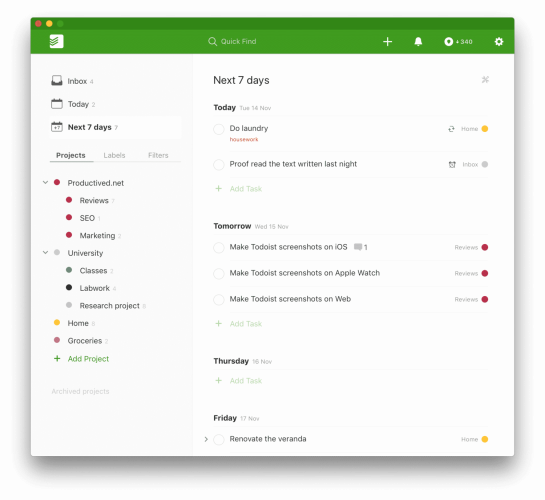
Google Keep
Google Keep (free) is probably the closest thing to a sticky note in the digital space. It would be an example for the simplest approach to task management, but can still be very successful and powerful. The focus here really lies on not providing many features, but keeping the app as simple as possible. If you like sticky notes, you will love Google Keep.
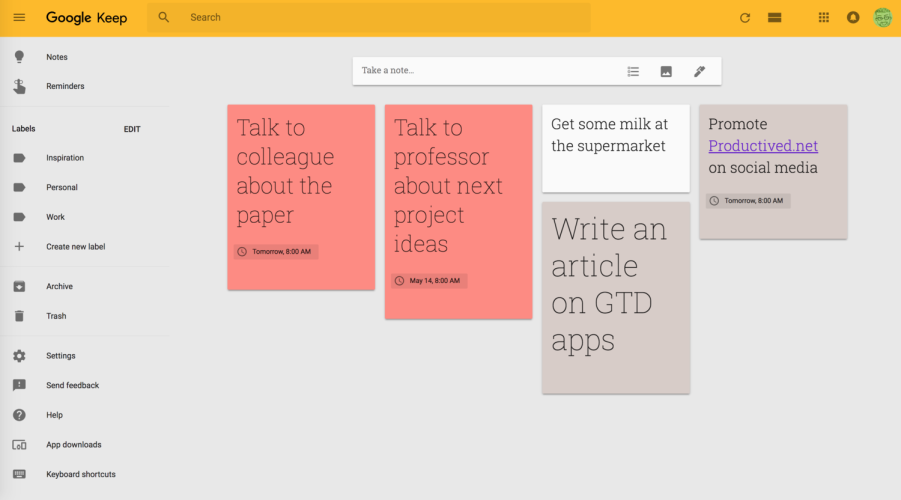
RememberTheMilk
RememberTheMilk (free with premium options) is one of the oldest contenders. The web service started 2004 and thus predates even OmniFocus and Things (which would otherwise be the oldest.) Most modern todo list applications seem to be modeled after the interface and structure of RememberTheMilk, which makes it the grandfather of many digital to-do list apps.
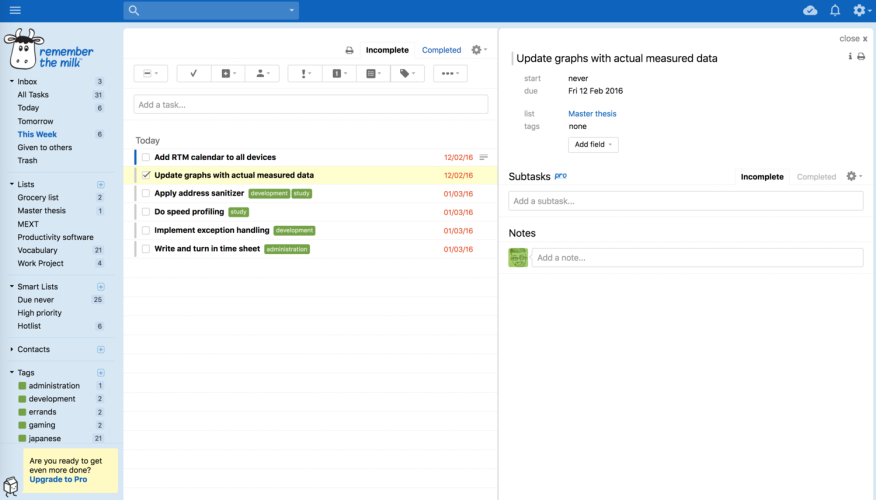
The web service felt rather abandoned for a long time, but recently got a complete refresh and is now modernized. In addition to the freemium web service, they also provide apps for Desktop and Mobile platforms.
A middle ground
In the following are some apps, which are somewhat on a middle ground. They have methodology attached and do not work as just a checklist, but rather come with their own approach to task management. They require almost no setup and can still be used out of the box, but one might need to learn how to use them, at least a tiny bit:
Things 3
Things 3 (my in-depth review / between $9.99 and $49.99 for different platforms) is an established todo list app for the Apple ecosystem since 2007.
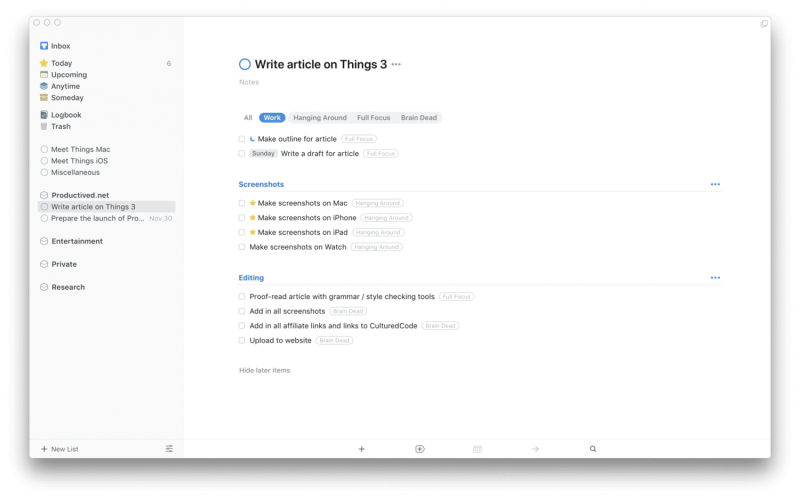
Fairly recently Things 3 revealed a complete rewrite of the suite, with a new design and improved functionality. It is a rather simple task list apps, but has a few features which might shift it half way to the section below.
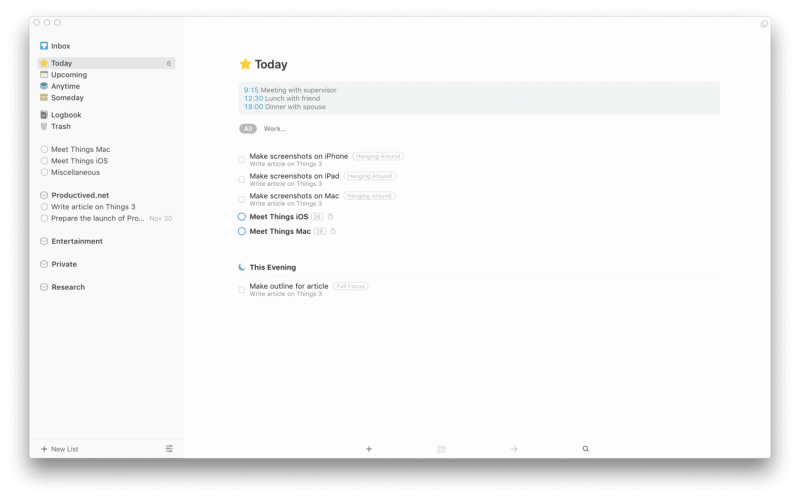
It is the perfect balance for use-cases where people want something with more advanced structuring, without being overwhelmed by too many options.
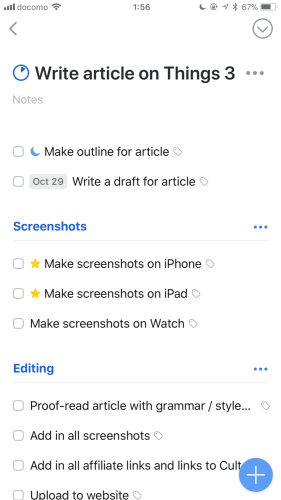
Things comes as three independent purchases for Mac, iPhone and iPad. The iPhone version also includes an Apple Watch companion app. While the full suite, if bought for all platforms, might be rather expensive, it is very polished and receives regular updates. Each app can also perfectly work on its own.

GTDNext
This next app (my in-depth review / free with premium options), well, the name basically says it. The target audience is enthusiasts of Getting Things Done. This service is completely optimized around GTD workflows. It uses terminology from the book, has all features described, and aims to be a full solution for GTD - while not being affiliated with them.
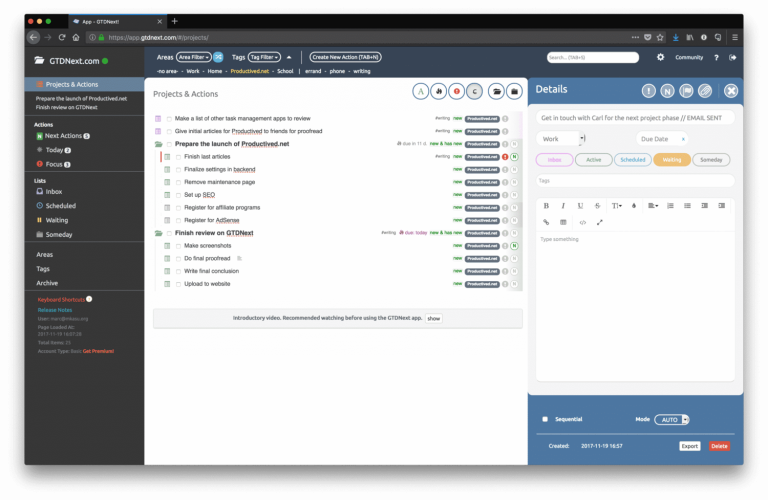
GTDNext focuses on only one thing but does it very well. They only provide a web service, accessible from any browser. This works on the Desktop but makes Mobile usage a little, subpar, as there are no mobile apps.
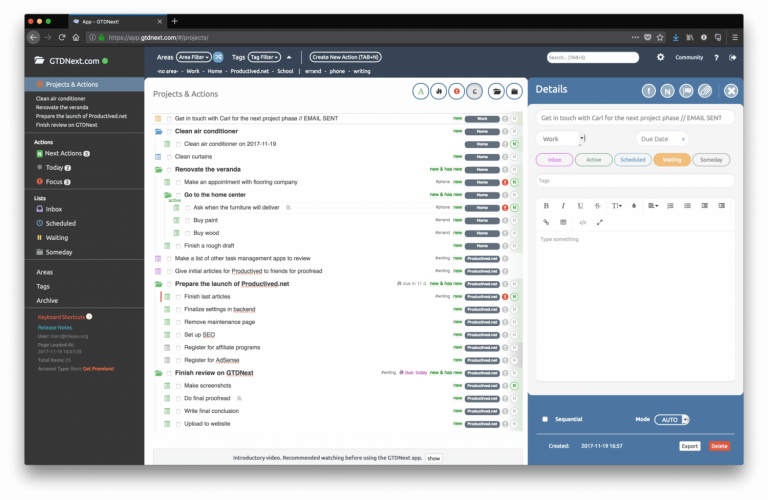
This app is as niche as it can get, but can be powerful for its audience. If being interested or involved with GTD methodology, it is definitely something to try out. We wrote an in-depth article on GTDNext.
NirvanaHQ
NirvanaHQ (free with premium options) goes for the same route as GTDNext, with a little less revealing name. The core methodology is pretty much GTD, and the app actually is pretty much the same as GTDNext. This is also mainly a web service, being accessible from the browser.
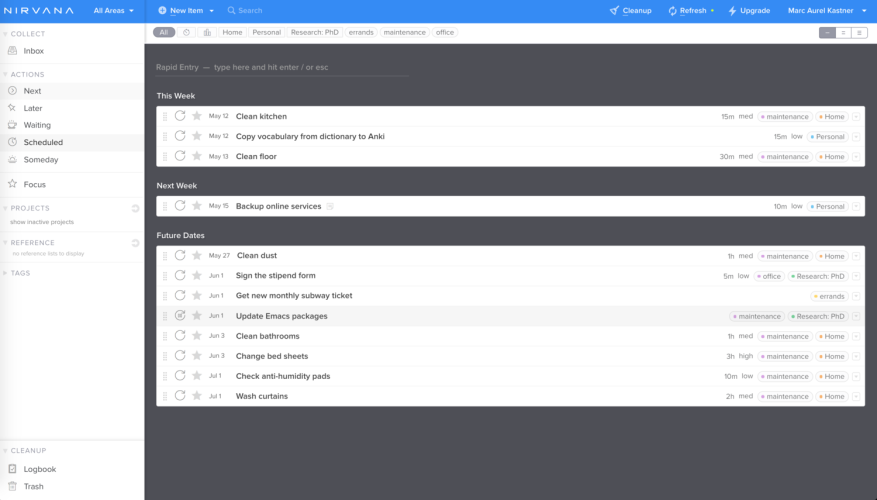
They also provide apps for iOS and Android, which makes mobile access a little bit easier than its contender. Overall, competition and having options are always great, isn’t it?
Complexity
When choosing a rather complex app, there are just as many options. In the following, a few promising options are discussed more closely. Which one suites best, that depends on the applied methodology. These apps have more options, customizability and complexity in general. This means, they also come with a steeper learning curve, as all their capabilities first need to be learned, set up and internalized.
OmniFocus 3
OmniFocus 3 (my in-depth review / between $39.99 and $79.99 for different platforms and pricing tiers) is one of the most famous solutions for task management.

Created by OmniGroup from 2007, it is a premium solution with a high price tag, but does not disappoint in quality and attention to detail. It allows both simple workflows or more advanced ones.
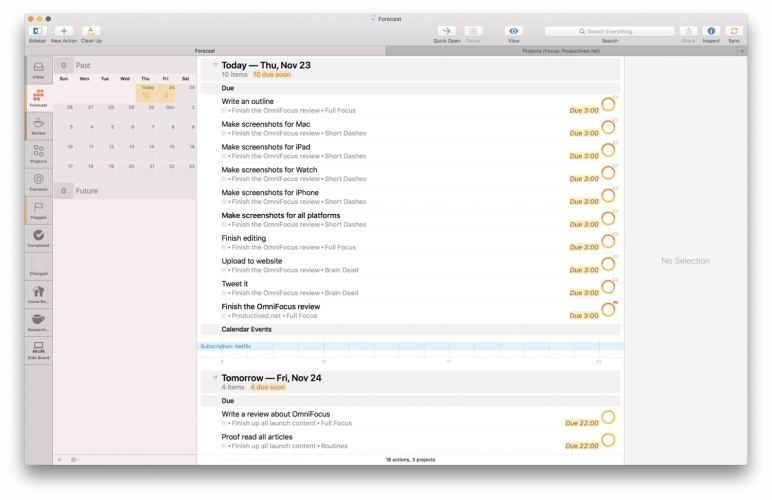
The application comes as either Standard or Pro. If choosing Standard, it is still a full-fledged task management suite exceeding the complexity of most.
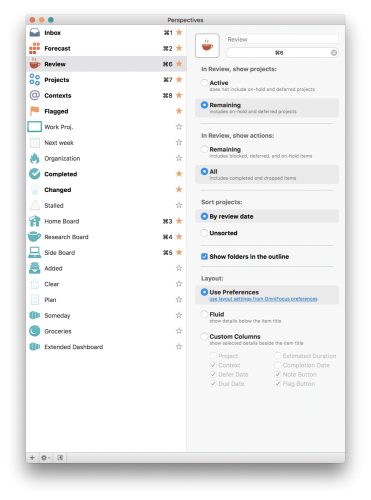
If going for Pro, it comes with yet another couple of advanced workflow opportunities for people who want perfect customization or more automation options.
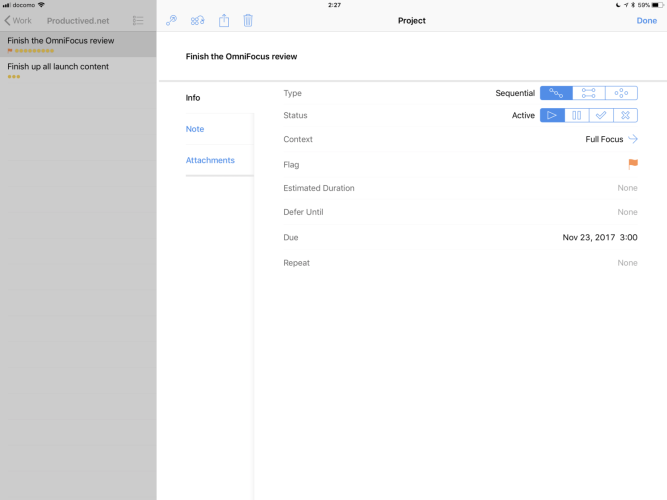
MyLifeOrganized
MyLifeOrganized (my in-depth review / free with premium or up to $59.95 depending on platform) is an even more complex alternative to OmniFocus 2 with a Windows client. It also supports both Android and iOS – so it only falls short for Mac users.
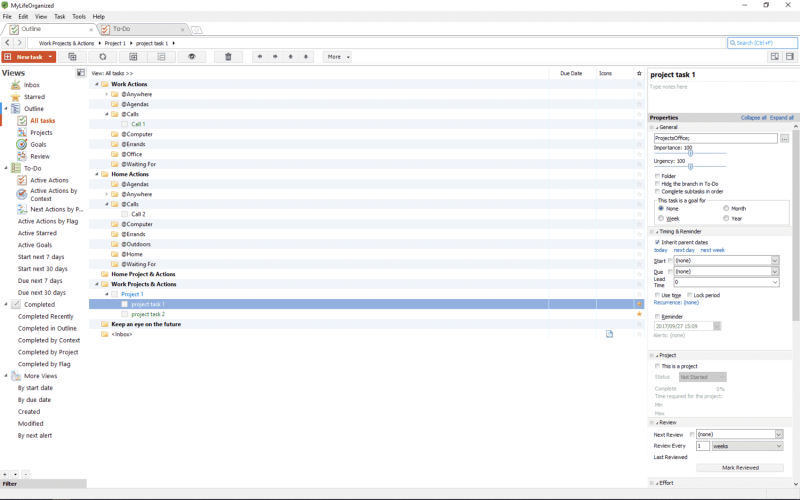
The app is a beast. It allows highly customizability of both UI and workflows. This way, it can adapt to virtually any workflow. It is by far the most complex productivity suite and can adjust to anything.
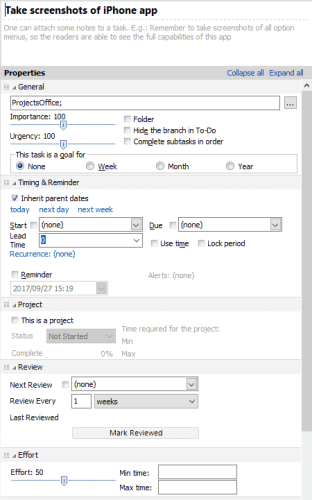
Even the introductory screen provides preset for a couple of completely different methodologies. The app is on the (most) advanced end of the spectrum. One can get anything out of MyLifeOrganized, except maybe simplicity. Some people want exactly that, other people might be intimidated.
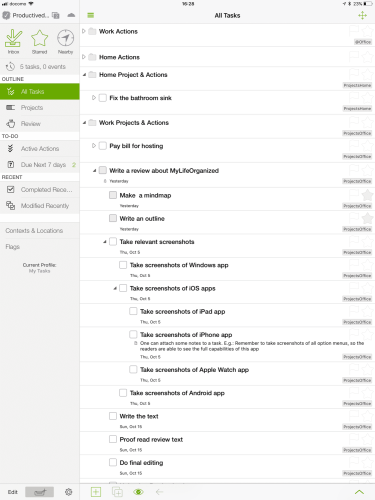
Project management and collaboration tools
Some apps are more targeted at teams and enterprise use. They allow project management on a larger scale with multiple users. That being said, usually, nothing stops one to use these apps for personal productivity.
Asana (free with premium options) and Trello (free with premium options) are two contenders in this category. They are both a rough mixture of task management and project management focused on team and collaboration. They are modeled after Agile development, a paradigm often used in Software Development for small and middle scale companies. Both allow Kanban boards, which might be an interesting feature even for solo usage.
When using Kanban boards, each task is represented by a card or sticky note. There are different categories, like “Pending”, “Analysis”, “Doing”, “Finished”. When reviewing tasks, each sticky node can move up and down from category to category. In these apps, there are graphical Kanban boards, which allow Drag and Drop, so this analog concept can be adapted to the digital screen.
While a majority of features in these apps are indeed targeted at collaboration, it will work as well for private projects or freelancing. It comes with the reliability and polishedness of enterprise solutions.
Some anecdotes
Before concluding this post with some TLDR recommendations, I felt it is time for some anecdotal icing.
For my own workflows, I used several apps for years. Of course, all apps reviewed and recommended on Productived.net are tested to a degree where I feel that I know enough about their capabilities to make a good judgement on them. But in the end, I need to settle on some solutions for my own productivity workflow.
I have been in use of OmniFocus since 2010, which was my start into the GTD method. I am also using it today, so this story could end here. However, as being very interested in productivity workflows and other apps, I have tested all kinds of apps over the years. Therefore, while my story starts and ends with the same app (at least for now,) I have been using all kinds of different apps in between. My current database is in OmniFocus, but due to the vast amount of options, that might change any day. I have been jumping between OmniFocus and MyLifeOrganized for the most part, as I enjoy the complexibility of each.
One app, which I used for a very long time, was Todoist. It is rather minimalistic and came in a rush of trying to simplify all my workflows. It worked pretty well for a long time. But in the end, I missed the thing which made the GTD methodology worthy for me: Getting things out of sight.
For me, deferred dates, paused projects and features like sequential projects help to keep things simple. While my task management tool has more than 800 tasks, I usually see less than fifty. Things are postponed to the future, or depent on other tasks to be finished first (next action lists!).
After Todoist, I tested various tools which were more intended towards GTD workflows. NirvanaHQ, GTDNext, and last MyLifeOrganized. All of them are great alternatives, and pretty closely resemble the things I wanted from a task management tool. Some missed things I wanted, but I would instantly recommend any of those.
MyLifeOrganized could keep me for a year. It is a great app, but the complexity, which I yearned for in the beginning, turned out to be a double sided knife. At some point, I felt the app is too open, too overwhelming, perhaps.
Right now, I am back and settled down with OmniFocus. For me, it has a great balance of productivity, quality software, and functionality. I can trust this software, and I like to use the software. Sometimes, it is as overwhelming as MyLifeOrganized, sometimes it is just perfect. On some days, I yearn for something much more simple, but switching to something simpler makes me miss so many other things.
A lot of movement over the years. Is it worth it? In my opinion yes. Regularly investigating all options keeps workflows clean. Thinking about what is actually important, what is distracting. This helps optimizing workflows, removing annoyances. Mitigating data to a new platform also feels like an overdue yearly review of all tasks, even more in depth than any monthly review would be.
In the end, task management software should be a blessing and fun to use. It is used more diligently if it is fun to use it. Whether I stay with my current solution, only time will tell. I am tempted to re-evaluate my choices regularly, and will probably still hop around for years. New applications come every day, other ones receive major updates, etc.
Conclusion
There are a lot of options for task management applications. It is wise to think about which features are needed, what kind of complexity would be the right amount. After deciding on this first, it usually comes down to two or three best fits. Read relevant reviews and tests. See which app feels the best.
- For a simple approach to task management, Todoist might be an app to start with. It has a simple yet powerful layout which might serve best for the most users, especially beginners.
- When complex features are needed, look into either OmniFocus or MyLifeOrganized.
- Last, if either option sounds too simple or too complex, Things 3 would be the best bet in a powerful, yet easy to use, middle ground.
In the end, it is important to establish trust. To establish trust, an app needs to feel right, but it also needs to be reliable. It is a choice for a longer term, so the options need to be evaluated thoroughly. But don’t worry, nothing is set in stone and feel free to jump between apps whenever getting unhappy.
Disclosure: This post may contain affiliate links. This means I may make a small commission if you make a purchase.
About me

Marc
I am a lecturer in field of computer science. I am interested in task- and knowledge management. Sometimes, I blog on productivity workflows, apps, and other related non-work stuff I'm working on.
See Also
GTDNext
This review takes a closer look at a task management service called GTDNext. The very acronymic name already tells half of the story: If …
Read More...MyLifeOrganized
MyLifeOrganized (short, MLO) is a beast. The main pillar of MLO is customization. It is a suite which comes with a preset interface, but …
Read More...OmniFocus 2
With its initial release in early 2008, OmniFocus grew to be one of the most prominent task management suites on the Apple ecosystem. It is …
Read More...